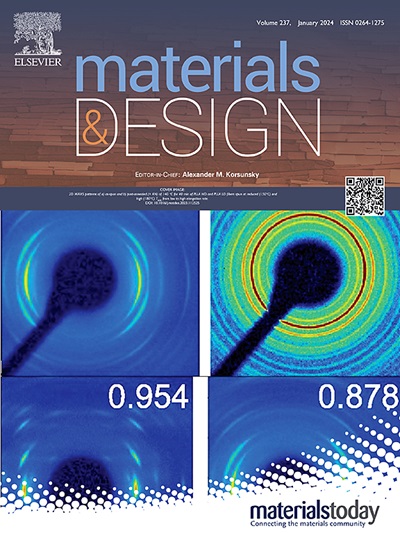Electronic density of states as the descriptor of elastic bond strength, ductility, and local lattice distortion in BCC refractory alloys
IF 7.6
2区 材料科学
Q1 MATERIALS SCIENCE, MULTIDISCIPLINARY
引用次数: 0
Abstract
Although electronic density of states (DOS) is fundamental to materials properties, its general relationship to mechanical properties of alloys is not well established. In this paper, using density functional theory (DFT) calculations, we show that the electronic occupancy at the Fermi level, N(Ef), obtained from DOS is a key descriptor of alloy strength and ductility. Our comprehensive analysis of numerous body centered cubic (BCC) refractory high entropy alloys (RHEAs) shows an overwhelming correlation that low N(Ef) indicates strong bonds that have high stiffness resulting in high elastic constants. High bond stiffness indicates presence of covalent nature of bonds that are directional in nature resulting in resistance to deformation leading to high bulk (B) and shear (G) moduli. Consequently, N(Ef) provides a direct correlation to the tendency of alloy ductility evidenced in the Pugh ratio (G/B). As stiffer bonds result in lower local lattice distortion (LLD), N(Ef) are LLD are also found to be corelated which opens up a correlation to solid solution strengthening and yield strength. Thus, this work unveils fundamental correlations between N(Ef) and (1) elastic bond strength, (2) ductility, and (3) LLD. These correlations open opportunities for the design of high strength high ductile RHEAs.

求助全文
约1分钟内获得全文
求助全文
来源期刊

Materials & Design
Engineering-Mechanical Engineering
CiteScore
14.30
自引率
7.10%
发文量
1028
审稿时长
85 days
期刊介绍:
Materials and Design is a multi-disciplinary journal that publishes original research reports, review articles, and express communications. The journal focuses on studying the structure and properties of inorganic and organic materials, advancements in synthesis, processing, characterization, and testing, the design of materials and engineering systems, and their applications in technology. It aims to bring together various aspects of materials science, engineering, physics, and chemistry.
The journal explores themes ranging from materials to design and aims to reveal the connections between natural and artificial materials, as well as experiment and modeling. Manuscripts submitted to Materials and Design should contain elements of discovery and surprise, as they often contribute new insights into the architecture and function of matter.
 求助内容:
求助内容: 应助结果提醒方式:
应助结果提醒方式:


